AI Use in Legal & Compliance Operations: Opportunities, Challenges and Ethics
Opportunities, challenges, and ethics concerns of AI use in legal and compliance operations.
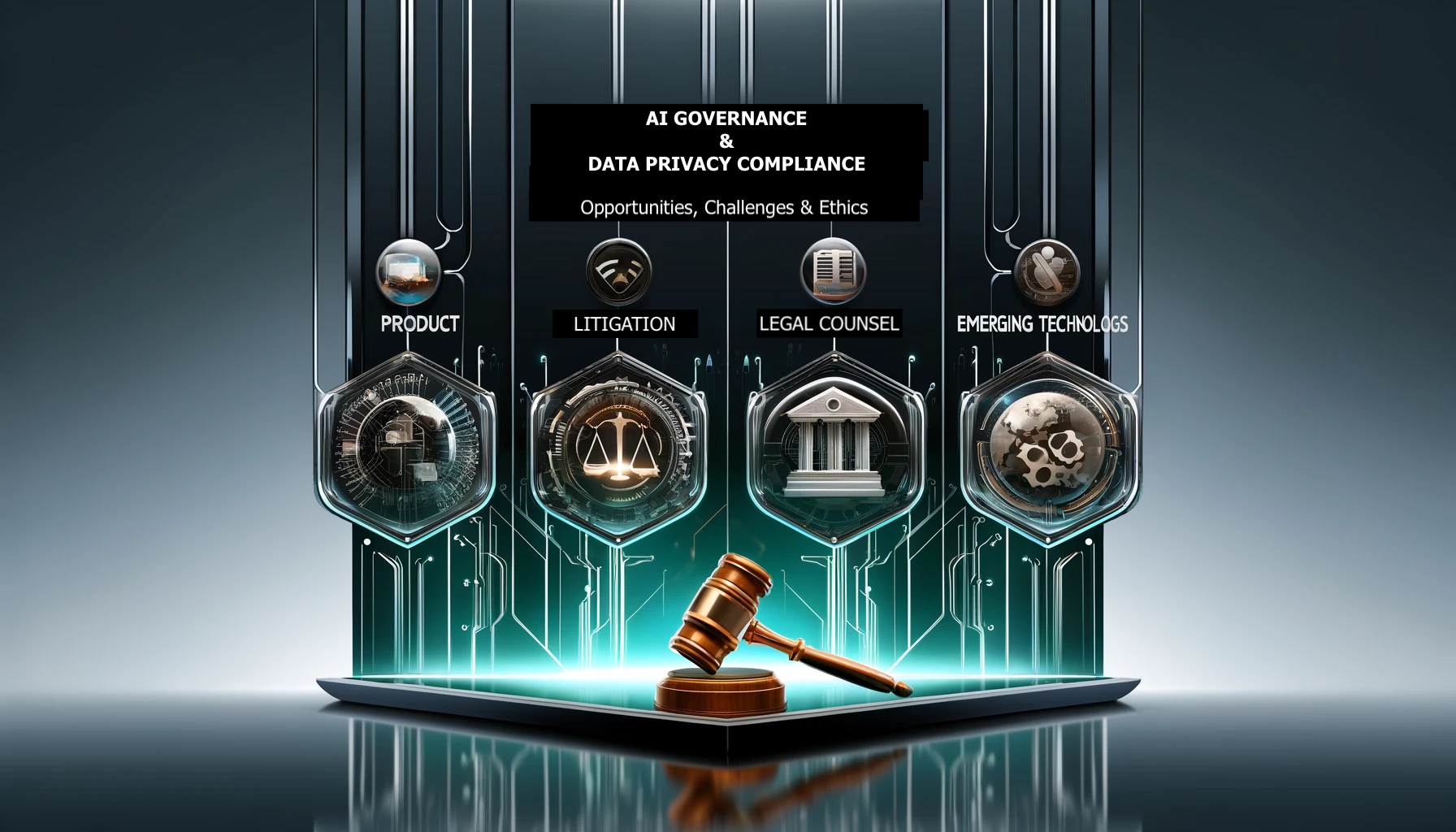
The surge in AI adoption has triggered a corresponding rise in concerns regarding the ethical, transparent, and responsible use of these technologies. AI governance has emerged as the cornerstone for responsible and trustworthy AI adoption. Organizations must proactively manage the entire AI life cycle, and strong ethical and risk-management frameworks are essential for navigating the complex landscape of AI applications.
This post specifically explores the opportunity presented by AI for transformation of business operations in regulatory compliance and legal profession, and the need to balance this capability with potential liability and ethical dilemmas as we embrace adopting AI in the practice of law.
Opportunity: Regulatory Compliance
What are the opportunities that AI presents in helping organizations improve their regulatory compliance operations?
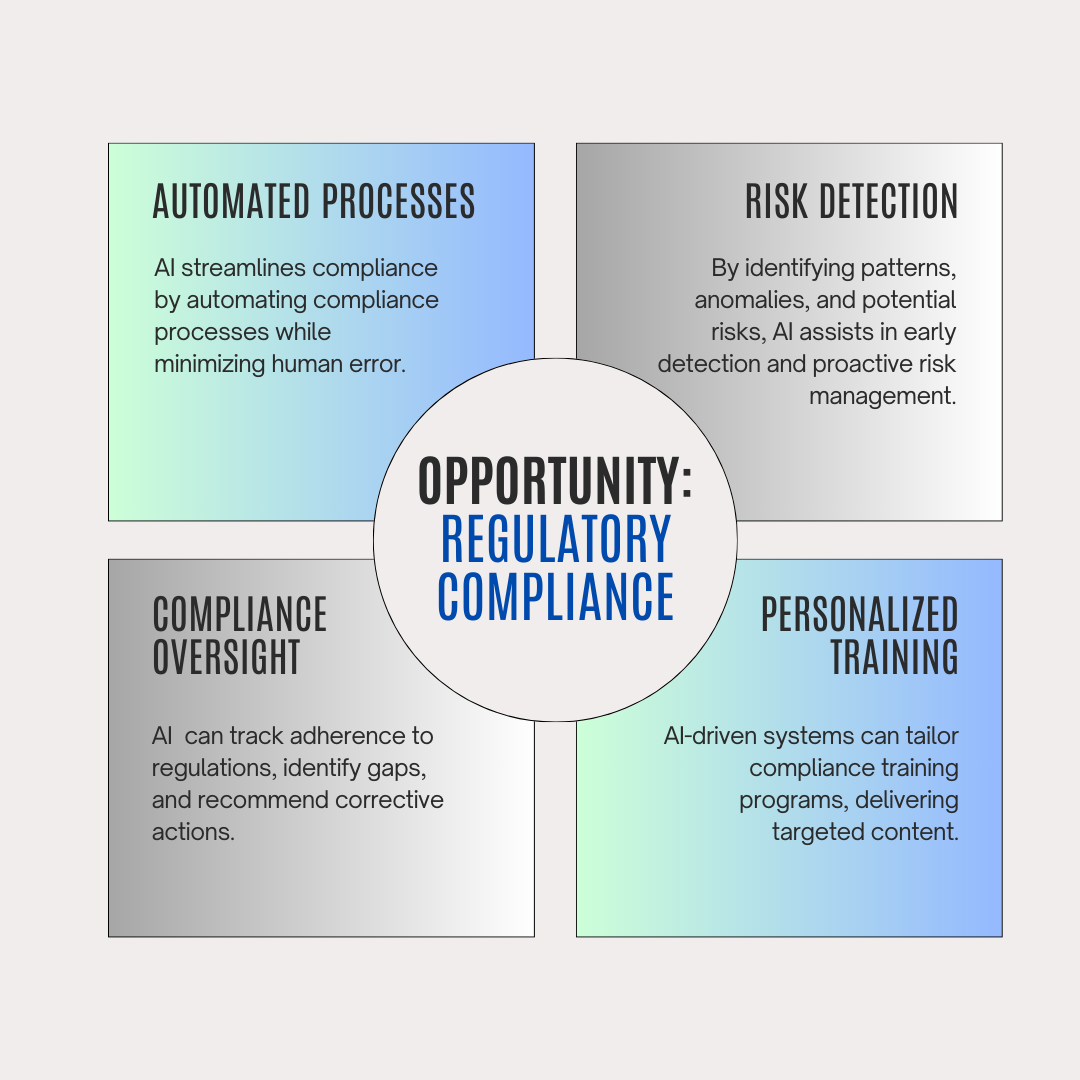
- Automated Compliance Processes: AI streamlines compliance by automating compliance processes while minimizing human error.
- Risk Detection: AI systems can analyze vast quantities of data in real-time, surpassing human capabilities. By identifying patterns, anomalies, and potential risks, AI assists in early detection and proactive risk management.
- Compliance Program Oversight: AI enables efficient monitoring of compliance programs. It can track adherence to regulations, identify gaps, and recommend corrective actions.
- Personalized Compliance Training: AI-driven systems can tailor compliance training programs, delivering targeted content.
How is AI being leveraged in emerging products to support the needs for legal and compliance professionals?
- Industry Adoption:
- Adoption rates vary across industries due to factors such as budget constraints, data security concerns, and the need for specialized expertise in implementing AI solutions effectively.
- Higher adoption within banking and financial services sector, and large corporations.
Opportunity: Legal Practice
What are the opportunities that AI presents to be safely leveraged in the practice of law?
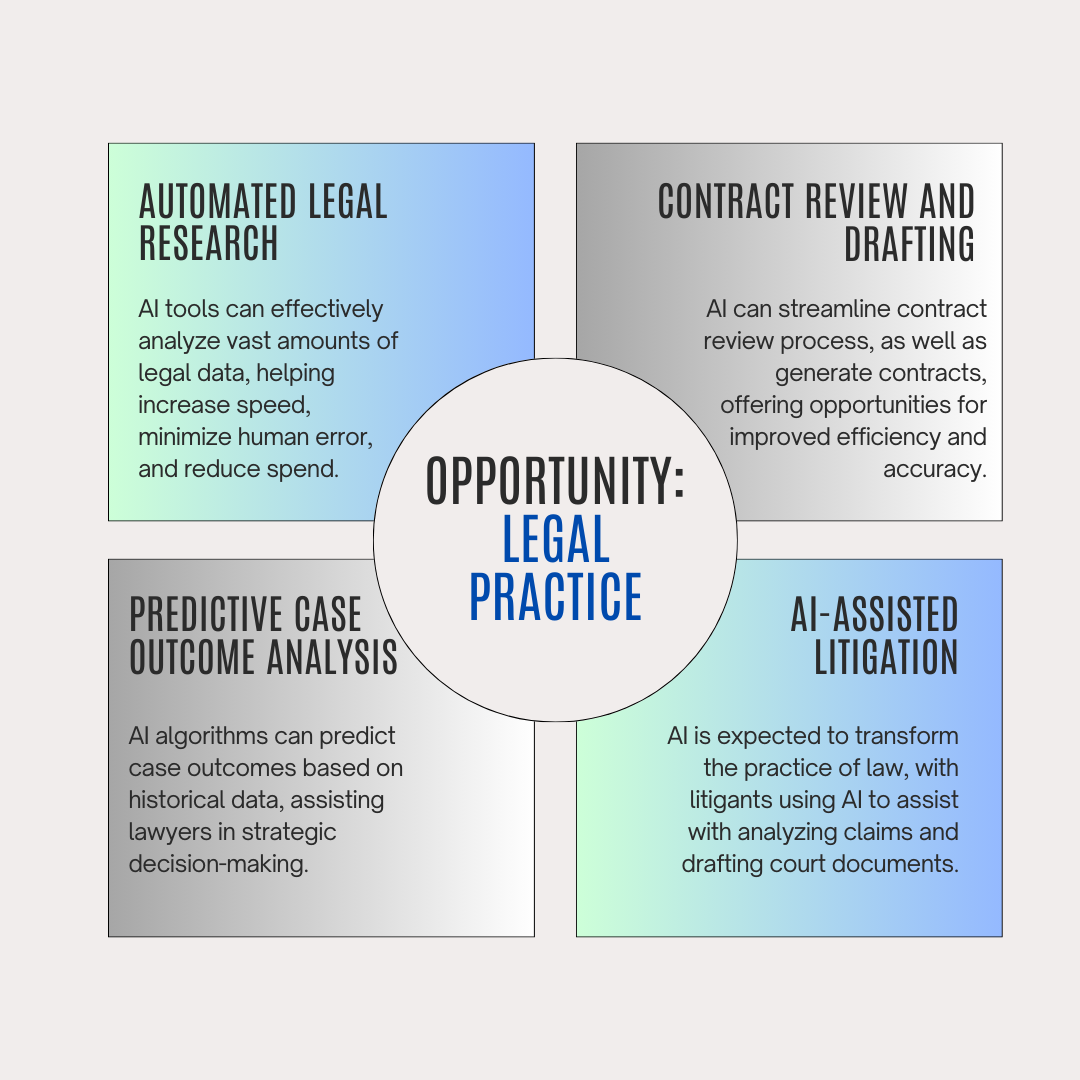
- Automated Legal Research: AI-powered tools can effectively analyze vast amounts of legal data, helping lawyers find relevant case law, statutes and precedents. This helps increase speed, minimize human error, and reduce spend.
- Contract Review and Drafting: AI can streamline contract review process, identifying key terms, risks, and inconsistencies, as well as generate contracts, agreements, and legal documents, offering opportunities for improved efficiency and accuracy.
- Predictive Case Outcome Analysis: AI algorithms can predict case outcomes based on historical data, assisting lawyers in strategic decision-making.
- AI-Assisted Litigation: AI is expected to transform the practice of law, with systems trained on legal materials designed to tackle specific, complex legal problems. Litigants are using AI to assist with analyzing claims and drafting court documents.
What do current trends suggest about how effective it could be when safely applied?
- Adoption Trends:
- Current trends indicate increasing adoption of AI in legal practice, with firms recognizing its potential to enhance efficiency and effectiveness.
- When safely applied, AI can significantly enhance legal operations. However, it’s essential to strike a balance between automation and human judgment.
Challenges: Legislative Trends
What legislative trends should organizations be watching out for to inform their governance and risk posture?
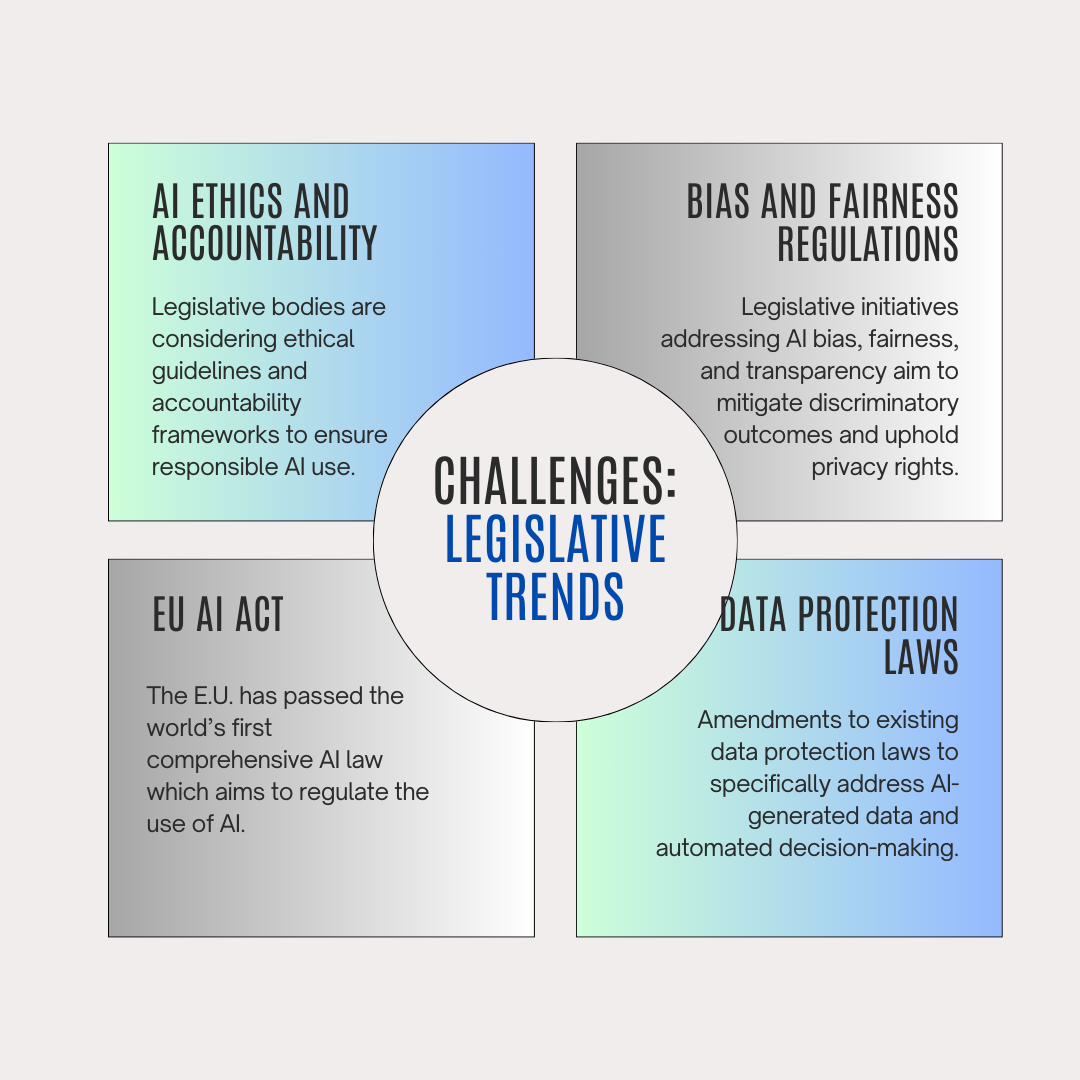
- AI Ethics and Accountability: Legislative bodies are considering ethical guidelines and accountability frameworks for AI development and deployment to ensure responsible AI use.
- Bias and Fairness Regulations: Legislative initiatives addressing AI bias, fairness, and transparency aim to mitigate discriminatory outcomes and uphold privacy rights.
- EU Artificial Intelligence Act (AI Act): The E.U. has passed the world’s first comprehensive AI law. Essentially it is product safety legislation which aims to regulate the use of AI. Taking a risk-based approach it categorizes AI systems based on risk levels. The law now covers generative AI models = unique challenges.
- Existing Data Protection Laws: Regulators are considering amendments to existing data protection laws to specifically address AI-generated data and automated decision-making.
What kind of enforcement trends can we expect in the future?
- Enforcement Trends
- Recent trends suggest that plaintiffs are looking for opportunities to file lawsuits against AI companies and AI adopters – these issues are related to privacy, bias, employment, intellectual property.
- Generative AI issues revolve around its tendency to replicate images, text, and more from the data used to train it, which raises questions about copyright infringement.
Challenges: Governance and Ethics
How can we ensure governance and ethics concerns are addressed when rolling out AI initiatives?
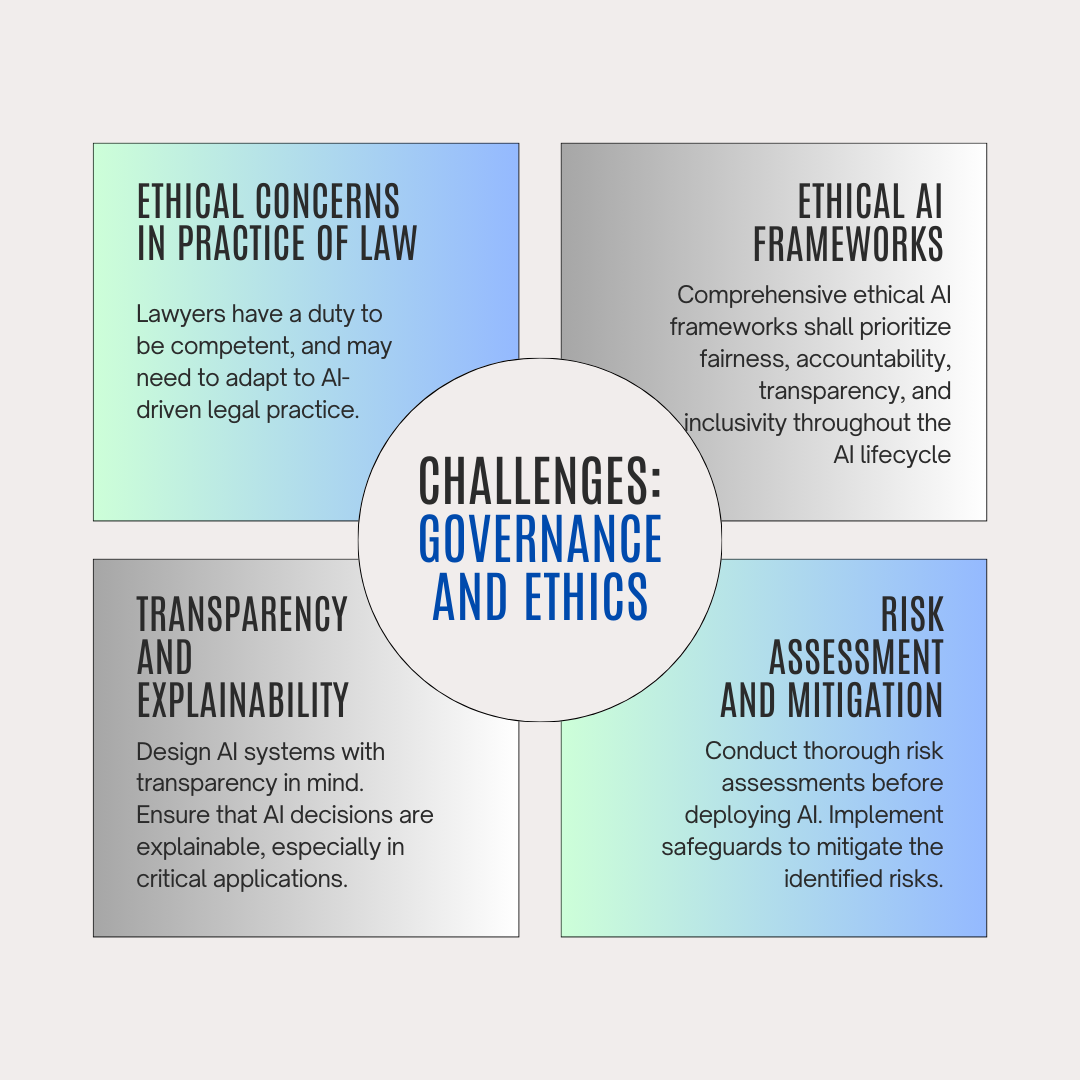
- Ethical Concerns in Practice of Law: Lawyers have a duty to be competent not only in the law and its practice, but also in technology. Also, future lawyers may need to adapt to AI-driven legal practice.
- Ethical AI Frameworks: Develop and adhere to comprehensive ethical AI frameworks that prioritize fairness, accountability, transparency, and inclusivity throughout the AI lifecycle, guiding decision-making and mitigating potential biases and discriminatory outcomes.
- Transparency and Explainability: Design AI systems with transparency in mind. Ensure that AI decisions are explainable, especially in critical applications.
- Risk Assessment and Mitigation: Conduct thorough risk assessments before deploying AI. Identify potential biases, unintended consequences, and risks to privacy. Implement safeguards to mitigate these risks.
Can tool vendors build safeguards in their products?
- Vendor Safeguards:
- Vendors play a critical role in building safeguards. Engage with AI vendors that prioritize governance and ethics by selecting vendors committed to building safeguards into their products.
- Integrate security and privacy protections into AI systems from the outset, such as encryption and anonymization, since AI systems may handle confidential client data. Implement robust cybersecurity practices to protect against breaches and unauthorized access.
Conclusion
The AI journey is no longer solely concerned with technological innovation; it is intrinsically tied to ethical, fair, and responsible AI deployment. By embracing AI ownership and establishing AI governance frameworks, organizations can realize the transformative potential of AI, while balancing innovation with compliance, regulatory, and ethical concerns.
Connect with us
If you would like to reach out for guidance or provide other input, please do not hesitate to contact us.
